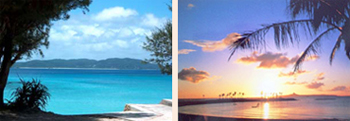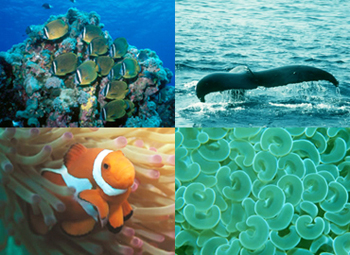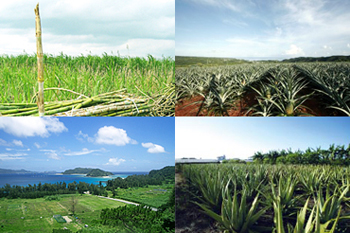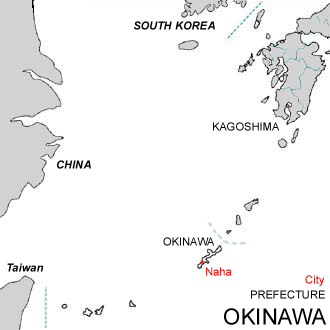Okinawa
Ryukyu
Karate is een krijgskunst die honderden jaren geleden is ontstaan op het eiland Okinawa. Okinawa maakt deel uit van de Ryukyu archipel. Deze archipel bestaat uit een keten van vier kleine eilandgroepen in de Stille Oceaan. De eilanden liggen voor de kust van China tussen Taiwan en Kyushu (Japan). Okinawa heeft als hoofdstad Nara is het grootste eiland van de Ryukyu archipel. Het kanji karakter voor Okinawa betekent ’touw in de open zee’. Het eiland heeft een grillige rotsachtige vorm. Het lijkt wat op een drijvend stuk touw in het water. 沖縄 (沖 oki, ‘op zee’ + 縄 nawa, ’touw’).

Okinawa kent een uitzonderlijk divers ecosysteem en heeft de meest prachtige koraalriffen in de wereld. Op de zeegras bedden in de oostkust verblijven zeekoeien, en zeeschildpadden. Deze komen ieder jaar naar de zuidelijke eilanden om daar hun eieren te leggen.

Het eiland staat bekend om zijn schoonheid, paradijselijkheid en natuurlijk zijn faam als de bakermat van karate. Tevens staan de Okinawa-eilanden bekend als ‘Geneeskrachtige Eilanden voor Gezondheid en hoge Ouderdom’. Op Okinawa wonen namelijk de gezondste mensen ter wereld! Het aantal (gezonde) honderdjarigen is nergens in de wereld zo hoog als in Okinawa.

Shangri-La
Okinawa’s ‘Shangri-La’? Het draait allemaal om matigheid en om het vinden van een balans in alle aspecten van het leven.
Okinawa-te

Okinawa’s gunstige oceanische ligging stimuleerde van oudsher overzeese culturele uitwisseling en handelscontacten met de omringende landen en steden. Alle belangrijke Aziatische steden zoals Shanghai, Hong Kong, Seoul, Manila, Taipei, en Tokyo zijn gelokaliseerd binnen een radius van 1500 km. Het meest bekende voorbeeld van Okinawa’s culturele export is wel karate dat is ontstaan uit
de nauwe banden met China en haar invloed op de Okinawaanse cultuur. Karate wordt beschouwd als een synthese van Chinees Kung Fu en de traditionele Okinawaanse krijgskunst; Okinawa-te.
Piraterij
De 15e eeuw was de ‘Gouden Eeuw van Handel’. Het onafhankelijke Ryukyu koninkrijk was in die periode een florerend handelscentrum geworden. Een constante dreiging voor het internationale handelsverkeer vormde echter de piraterij. De Okinawaanse zeelieden hadden behoefte aan bescherming hiertegen. Vanuit deze achtergrond ontwikkelde zich de Okinawaanse krijgskunst. Vechttechnieken uit met name de Chinese- en ook andere zuidoost Aziatische krijgskunsten werden hierin door de Okinawanen geïncorporeerd.
Shogunaat van Japan
Aan de onafhankelijkheid van Okinawa kwam in 1609 een einde. De Japanse Satsuma-clan Okinawa viel het eiland binnen. Het koninkrijk Ryukyu werd opgenomen in het shogunaat van Japan. Toch bleef het semi-onafhankelijk en onderhield ook betrekkingen met China. In 1879 werd het door Japan volledig geannexeerd. De Satsuma clan voerde begin 1600 op de Ryukyu-eilanden een algemeen wapenverbod in. Voor de Okinawanen was dit een tweede periode waarin het voor hen niet toegestaan was wapens te bezitten of krijgskunsten te beoefenen. Eerder in 1477 was al eens een wapenverbod ingevoerd.
In het geheim
Ondanks het wapenverbod, vormde deze perioden een gunstige context voor de ontwikkeling van de ongewapende zelfverdedigingskunst Okinawa-te. Deze kunst werd uitsluitend in het grootste geheim beoefend en voor buitenstaanders verborgen gehouden. De kunst werd volgens traditie mondeling overgebracht van leraar tot leerling . Hierdoor zijn er nauwelijks boeken of geschreven getuigenissen. Pas eind negentienhonderd werd het verbod op de martiale kunsten opgeheven. Na het uiteenvallen van het koninkrijk en de volledige annexatie door Japan in 1879 werd de krijgskunst opgenomen in het openbare onderwijssysteem van Okinawa. Niet veel later, circa 1910-1926 ontstonden de eerste publieke demonstraties op het vasteland van Japan.
Ryukyu [English narrative below]
Karate is a martial art that originated hundreds of years ago on the island of Okinawa. Okinawa is part of the Ryukyu archipelago. This archipelago consists of a chain of four small island groups in the Pacific Ocean. The islands lie off the coast of China between Taiwan and Kyushu (Japan). Okinawa with its capital Nara is the largest island of the Ryukyu archipelago. The character for Okinawa means ‘rope in the open sea’. The island has a whimsical rocky shape. It looks a bit like a floating piece of rope in the water. 沖 縄 (沖 oki, ‘at sea’ + 縄 nawa, ‘rope’).

Okinawa has an exceptionally diverse ecosystem and has the most beautiful coral reefs in the world. Sea cows and sea turtles reside on the sea grass beds in the east coast. These come to the southern islands every year to lay their eggs there.

Okinaw is known for its beauty, paradise and of course its fame as the birthplace of karate. Okinawa Islands are also known as ‘Healing Islands of Health and Longevity’. The healthiest people in the world live on Okinawa! The number of (healthy) centenarians is nowhere else in the world as high as in Okinawa.

Shangri-La
Okinawa’s “Shangri-La”? It’s all about moderation and finding a balance in all aspects of life.
Okinawa-te

Okinawa’s favorable oceanic location has traditionally encouraged overseas cultural exchanges and trade contacts with neighboring countries and cities. All major Asian cities such as Shanghai, Hong Kong, Seoul, Manila, Taipei, and Tokyo are located within a radius of 1500 km. The most well-known example of Okinawa’s cultural export is karate that arose from the close ties with
China and its influence on Okinawa’s culture. Karate is considered a synthesis of Chinese Kung Fu and the traditional Okinawian martial art; Okinawa-te.
Piracy
The 15th century was the “Golden Age of Trade”. The independent Ryukyu kingdom had become a flourishing trade center in that period. However, a constant threat to international trade was piracy. The Okinawan seamen needed protection against this. Okinawan martial art was born from this background. Fighting techniques from the Chinese and other Southeast Asian martial arts in particular were incorporated in this by the Okinawans.
Shogunate from Japan
The independence of Okinawa came to an end in 1609. The Japanese Satsuma clan Okinawa invaded the island. Kingdom of Ryukyu was incorporated into the shogunate of Japan. Nevertheless, it remained semi-independent and also maintained relations with China. In 1879 it was completely annexed by Japan. The Satsuma clan introduced a general arms ban on the Ryukyu Islands in the early 1600s. For the Okinawans, this was a second period in which they were not allowed to own weapons or practice martial arts. Earlier in 1477 a weapons ban had already been introduced.
In secret
Despite the prohibition of weapons, these periods formed a favorable context for the development of the unarmed self-defense art of Okinawa. This art was only practiced in the greatest secrecy and concealed from outsiders. The art was traditionally transferred orally from teacher to student. As a result, there are hardly any books or written testimonials. The ban on martial arts was not lifted until the end of nineteen hundred. After the breakup of the kingdom and the full annexation by Japan in 1879, the martial arts were incorporated into the public education system of Okinawa. Not much later, around 1910-1926, the first public demonstrations arose on mainland Japan.
Comments are closed.